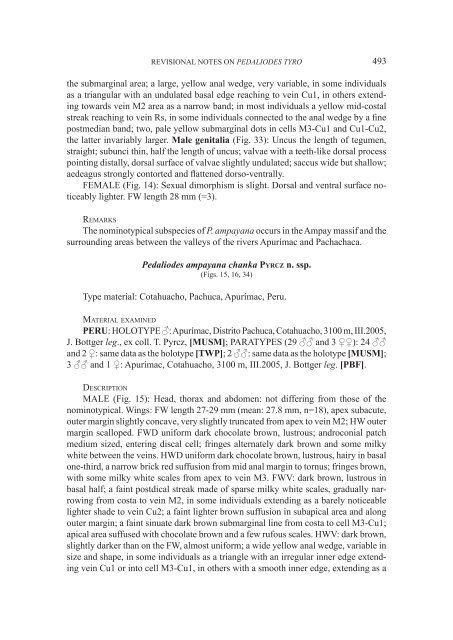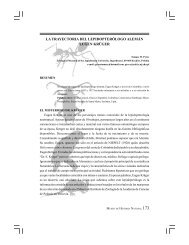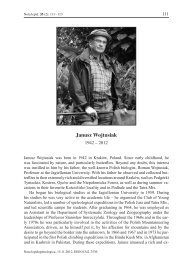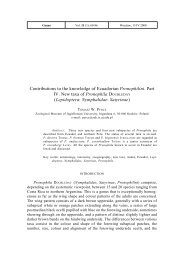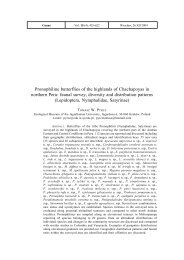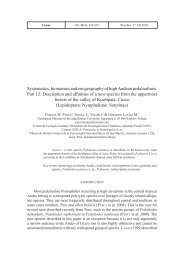Systematics, bionomics and zoogeography of high Andean ...
Systematics, bionomics and zoogeography of high Andean ...
Systematics, bionomics and zoogeography of high Andean ...
Create successful ePaper yourself
Turn your PDF publications into a flip-book with our unique Google optimized e-Paper software.
Revisional notes on Pedaliodes tyro<br />
493<br />
the submarginal area; a large, yellow anal wedge, very variable, in some individuals<br />
as a triangular with an undulated basal edge reaching to vein Cu1, in others extending<br />
towards vein M2 area as a narrow b<strong>and</strong>; in most individuals a yellow mid-costal<br />
streak reaching to vein Rs, in some individuals connected to the anal wedge by a fine<br />
postmedian b<strong>and</strong>; two, pale yellow submarginal dots in cells M3-Cu1 <strong>and</strong> Cu1-Cu2,<br />
the latter invariably larger. Male genitalia (Fig. 33): Uncus the length <strong>of</strong> tegumen,<br />
straight; subunci thin, half the length <strong>of</strong> uncus; valvae with a teeth-like dorsal process<br />
pointing distally, dorsal surface <strong>of</strong> valvae slightly undulated; saccus wide but shallow;<br />
aedeagus strongly contorted <strong>and</strong> flattened dorso-ventrally.<br />
FEMALE (Fig. 14): Sexual dimorphism is slight. Dorsal <strong>and</strong> ventral surface noticeably<br />
lighter. FW length 28 mm (=3).<br />
Remarks<br />
The nominotypical subspecies <strong>of</strong> P. ampayana occurs in the Ampay massif <strong>and</strong> the<br />
surrounding areas between the valleys <strong>of</strong> the rivers Apurímac <strong>and</strong> Pachachaca.<br />
Pedaliodes ampayana chanka Pyrcz n. ssp.<br />
(Figs. 15, 16, 34)<br />
Type material: Cotahuacho, Pachuca, Apurímac, Peru.<br />
Material examined<br />
PERU: HOLOTYPE ♂: Apurímac, Distrito Pachuca, Cotahuacho, 3100 m, III.2005,<br />
J. Bottger leg., ex coll. T. Pyrcz, [MUSM]; PARATYPES (29 ♂♂ <strong>and</strong> 3 ♀♀): 24 ♂♂<br />
<strong>and</strong> 2 ♀: same data as the holotype [TWP]; 2 ♂♂: same data as the holotype [MUSM];<br />
3 ♂♂ <strong>and</strong> 1 ♀: Apurímac, Cotahuacho, 3100 m, III.2005, J. Bottger leg. [PBF].<br />
Description<br />
MALE (Fig. 15): Head, thorax <strong>and</strong> abdomen: not differing from those <strong>of</strong> the<br />
nominotypical. Wings: FW length 27-29 mm (mean: 27.8 mm, n=18), apex subacute,<br />
outer margin slightly concave, very slightly truncated from apex to vein M2; HW outer<br />
margin scalloped. FWD uniform dark chocolate brown, lustrous; <strong>and</strong>roconial patch<br />
medium sized, entering discal cell; fringes alternately dark brown <strong>and</strong> some milky<br />
white between the veins. HWD uniform dark chocolate brown, lustrous, hairy in basal<br />
one-third, a narrow brick red suffusion from mid anal margin to tornus; fringes brown,<br />
with some milky white scales from apex to vein M3. FWV: dark brown, lustrous in<br />
basal half; a faint postdical streak made <strong>of</strong> sparse milky white scales, gradually narrowing<br />
from costa to vein M2, in some individuals extending as a barely noticeable<br />
lighter shade to vein Cu2; a faint lighter brown suffusion in subapical area <strong>and</strong> along<br />
outer margin; a faint sinuate dark brown submarginal line from costa to cell M3-Cu1;<br />
apical area suffused with chocolate brown <strong>and</strong> a few rufous scales. HWV: dark brown,<br />
slightly darker than on the FW, almost uniform; a wide yellow anal wedge, variable in<br />
size <strong>and</strong> shape, in some individuals as a triangle with an irregular inner edge extending<br />
vein Cu1 or into cell M3-Cu1, in others with a smooth inner edge, extending as a


